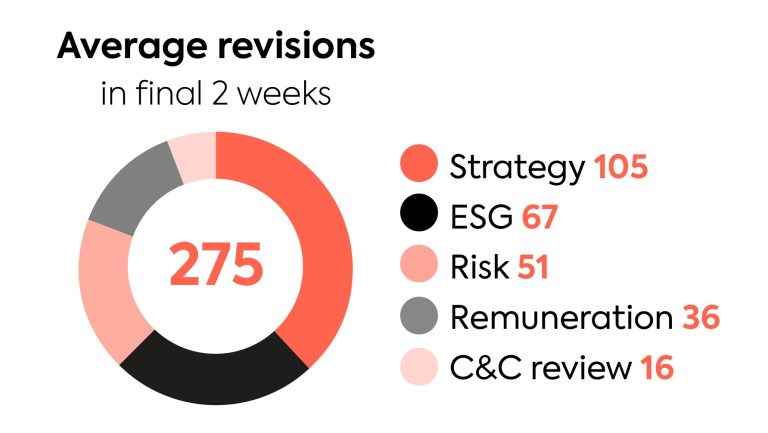Enhancing the corporate reporting process.
The annual report. For many companies, these words evoke thoughts of poorly edited drafts, countless data syncs, tiresome triple-checking, repetitive revisions, back-and-forth with departments, and hours spent racing the clock. If you’ve been or currently still are in the midst of it all, you know the production process is always stressful and often rife with inefficiencies. To shed light on some classic annual reporting frustrations a recent survey* studied the behavior of various companies during the last reporting season. With several interesting and intriguing findings as a result. How to strive for an effective and accurate production process seems to be a quest for most organizations when meeting their ever more complex reporting needs.
Two content streams. Many complications.
The average production process involves two content streams: the narrative sections and the financial sections of the annual report. While the front sections of the annual report contain narrative content (e.g. activity report), the back sections feature more numbers-driven material (e.g. financial statements and notes). Each content stream comes with its own nuances and complications. At first glance alone, these processes can be incredibly frustrating. Riddled with inefficiencies and always ripe for improvement.
Presenting the numbers.
Many finance departments use a disclosure management system to populate the back sections of the report: producing the tables in the financial statements and the commentary in accompanying notes. After delivering their results to the annual report project manager, finance often considers their job done. But it’s not. In reality, it’s only just begun. Research shows that clients synced their data an average of 41 times. Requesting updates and compulsively checking for mistakes can be quite a hassle.
Telling the story.
Collaboration is key across the entire production process — but especially in regards to the narrative sections of the annual report. Here, the text is massaged, tweaked, and discussed, infographics are continually updated, board photos are retouched, and elements are regularly moved around last-minute. According to the same survey, companies make an average of 275 revisions to their annual report in the last two weeks before publication.

These statistics show that companies have a great need for collaboration and crave the ability to manage final changes and immediate edits while working continuous on mostly the narrative parts of the annual report.
Devise your approach.
Publishing an annual report is a major milestone in every organization’s calendar. No doubt it can be stressful as there is so much to remember. But if you want to create a report that ticks all the regulatory compliance boxes, as well as standing out for all the right reasons among your competitors, having a clear plan of action is essential. As there are no ready-made solutions, your reporting process should always be tailored.
Know what’s coming.
While many companies like to postpone post-publication evaluations, we view such project reviews as crucial steppingstones for progress. A strategic analysis meticulously assesses every aspect of the design and production process to pinpoint any discrepancies between the final output and the original objectives related to approach, content, narrative, layout and technology. Such a systematic analysis provides actionable insights, allowing organizations to identify opportunities to enhance impact and quality of future reports. The insights gained lead to tailored recommendations that address the unique reporting challenges faced by each organization. Understanding the organizational impact of reporting is crucial for crafting effective storytelling and streamlining the entire production process.
Do you wonder how to optimize your reporting? TD Cascade is happy to help. Contact us to initiate a conversation that may transform your approach to corporate reporting—no strings attached.




